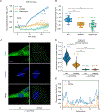Rheb regulates nuclear mTORC1 activity independent of farnesylation
- PMID: 35294906
- PMCID: PMC9667991
- DOI: 10.1016/j.chembiol.2022.02.006
Rheb regulates nuclear mTORC1 activity independent of farnesylation
Abstract
The small GTPase Ras homolog enriched in brain (Rheb) plays a critical role in activating the mechanistic target of rapamycin complex 1 (mTORC1), a signaling hub that regulates various cellular functions. We recently observed nuclear mTORC1 activity, raising an intriguing question as to how Rheb, which is known to be farnesylated and localized to intracellular membranes, regulates nuclear mTORC1. In this study, we found that active Rheb is present in the nucleus and required for nuclear mTORC1 activity. We showed that inhibition of farnesyltransferase reduced cytosolic, but not nuclear, mTORC1 activity. Furthermore, a farnesylation-deficient Rheb mutant, with preferential nuclear localization and specific lysosome tethering, enables nuclear and cytosolic mTORC1 activities, respectively. These data suggest that non-farnesylated Rheb is capable of interacting with and activating mTORC1, providing mechanistic insights into the molecular functioning of Rheb as well as regulation of the recently observed, active pool of nuclear mTORC1.
Keywords: Compartmentation; PTM; TSC; biosensor; lipid modification; mTOR; small GTPase.
Copyright © 2022 Elsevier Ltd. All rights reserved.
Conflict of interest statement
Declaration of interests The authors declare no competing interests.
Figures




Similar articles
-
Weak membrane interactions allow Rheb to activate mTORC1 signaling without major lysosome enrichment.Mol Biol Cell. 2019 Oct 15;30(22):2750-2760. doi: 10.1091/mbc.E19-03-0146. Epub 2019 Sep 18. Mol Biol Cell. 2019. PMID: 31532697 Free PMC article.
-
Control of TSC2-Rheb signaling axis by arginine regulates mTORC1 activity.Elife. 2016 Jan 7;5:e11058. doi: 10.7554/eLife.11058. Elife. 2016. PMID: 26742086 Free PMC article.
-
Redox regulates mammalian target of rapamycin complex 1 (mTORC1) activity by modulating the TSC1/TSC2-Rheb GTPase pathway.J Biol Chem. 2011 Sep 16;286(37):32651-60. doi: 10.1074/jbc.M111.238014. Epub 2011 Jul 22. J Biol Chem. 2011. PMID: 21784859 Free PMC article.
-
Coordination of Rheb lysosomal membrane interactions with mTORC1 activation.F1000Res. 2020 May 27;9:F1000 Faculty Rev-450. doi: 10.12688/f1000research.22367.1. eCollection 2020. F1000Res. 2020. PMID: 32518628 Free PMC article. Review.
-
Amino acid regulation of TOR complex 1.Am J Physiol Endocrinol Metab. 2009 Apr;296(4):E592-602. doi: 10.1152/ajpendo.90645.2008. Epub 2008 Sep 2. Am J Physiol Endocrinol Metab. 2009. PMID: 18765678 Free PMC article. Review.
Cited by
-
Visualization of Subcellular mTOR Complex 1 Activity with a FRET-Based Sensor (TORCAR).Methods Mol Biol. 2025;2882:139-162. doi: 10.1007/978-1-0716-4284-9_7. Methods Mol Biol. 2025. PMID: 39992508
-
Conformation-specific synthetic intrabodies modulate mTOR signaling with subcellular spatial resolution.Proc Natl Acad Sci U S A. 2025 Jun 17;122(24):e2424679122. doi: 10.1073/pnas.2424679122. Epub 2025 Jun 9. Proc Natl Acad Sci U S A. 2025. PMID: 40489625
-
mTORopathies in Epilepsy and Neurodevelopmental Disorders: The Future of Therapeutics and the Role of Gene Editing.Cells. 2025 Apr 30;14(9):662. doi: 10.3390/cells14090662. Cells. 2025. PMID: 40358185 Free PMC article. Review.
-
Roles of small GTPases in cardiac hypertrophy (Review).Mol Med Rep. 2024 Nov;30(5):208. doi: 10.3892/mmr.2024.13332. Epub 2024 Sep 20. Mol Med Rep. 2024. PMID: 39301654 Free PMC article. Review.
-
Nuclear mTOR Signaling Orchestrates Transcriptional Programs Underlying Cellular Growth and Metabolism.Cells. 2024 May 3;13(9):781. doi: 10.3390/cells13090781. Cells. 2024. PMID: 38727317 Free PMC article. Review.
References
-
- Basso AD, Mirza A, Liu G, Long BJ, Bishop WR, Kirschmeier P, 2005. The farnesyl transferase inhibitor (FTI) SCH66336 (lonafarnib) inhibits Rheb farnesylation and mTOR signaling. Role in FTI enhancement of taxane and tamoxifen anti-tumor activity. J. Biol. Chem. 280, 31101–31108. doi:10.1074/jbc.M503763200 - DOI - PubMed
Publication types
MeSH terms
Substances
Grants and funding
LinkOut - more resources
Full Text Sources
Other Literature Sources
Research Materials
Miscellaneous

